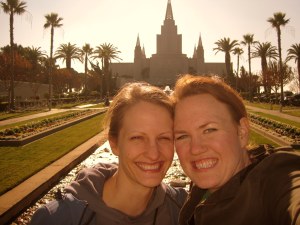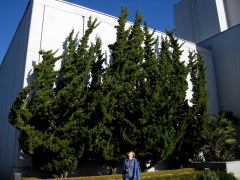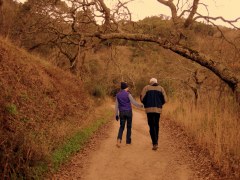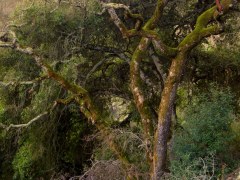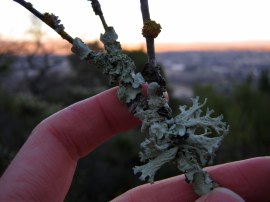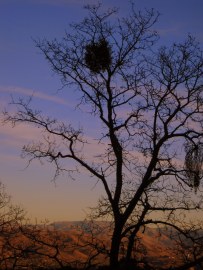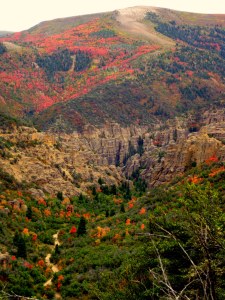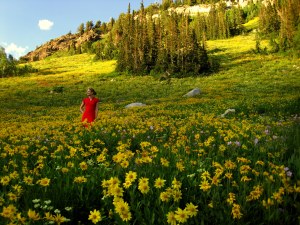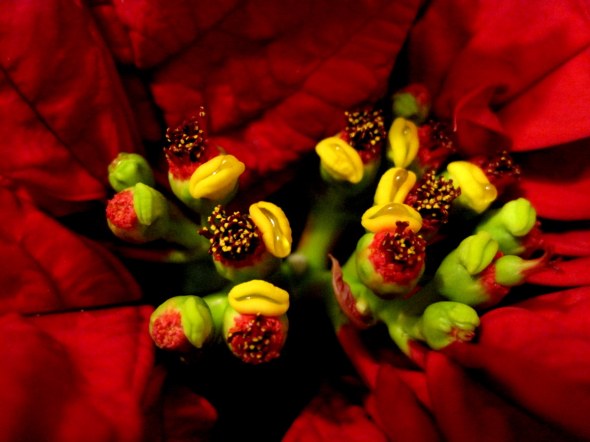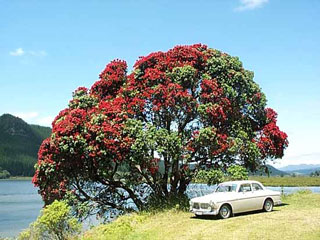also while in California….
Posted: January 11, 2012 Filed under: Uncategorized | Tags: botany, friends, holidays, light, plants, seasons, sunset, Wisconsin 1 CommentI spent a few days with Lydia, my dear friend and long-ago mission trainee.
My Wisconsin-centric brain was so giddy to spend Christmas Eve playing outside in 60 degree weather. I went barefoot as often as I could.
Lydia’s great family and I shared colorful stories, ate mind-numbingly-delicious food, hiked abundant countryside, discussed heart-expanding topics, evangelized the wonders of kefir (which may or may not actually be manna), sweat liters at the Bikram yoga studio, and slept in as long as we wanted. Looking back through my camera, it turns out I mainly just took photos of plants.
Schizocarps!
Posted: November 28, 2011 Filed under: Uncategorized | Tags: botany, earth, frolicks, Phi, plants, seasons, soil, spirals 1 CommentI found my old nature journal this week. My last entry, dated Fall 2008, inspired me to fulfill a dream I’ve been scheming for some time now. I woke up early Sunday morning to begin gathering schizocarps–those helicopters that fall from maple trees–from around my neighborhood. Thanks to the three friends who helped me gather these wonders throughout the day. I will still need to gather more before our next snow fall, if anyone else is interested in helping 🙂 First I’ll share the journal entry, then I’ll tell you about my dream that will soon become reality…
…
Fall 2008I have become enamored by schizocarps. Seriously?! Billions of twirly-birds all falling to the earth in unison?! Billions of winged maples-in-embryo spiraling over the Northern Hemisphere. Billions over BYU’s campus alone. One afternoon I gathered 4 grocery sacks of schizocarps. It took no more than two hours with 2 of us gathering. The street gutters were lined with them. The grass cupped them like children hoarding candy on Halloween. The sidewalks were blanketed with them- all facing the way of the wind. In the half-inch cracks between cemented sidewalk slabs, schizocarps were packed tightly, nose down, just like an over-zealous litter of piglettes all trying to get a mouthful of teat. I like that metaphor: the Earth as a giant mammary gland, a wellspring of mother’s milk. Countless numbers of tongue-like roots pressing earth-ward, pulling in moisture and nutrients, grabbing hold to the solid ground. Filling and stabilizing. Supporting and nurturing.
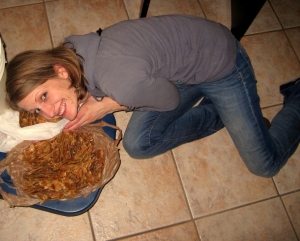
My plan is to find a nice courtyard with high walls from which the thousands of schizocarps can be let loose. While the magical spirals descend, people will dance and frolic. Doesn’t it sound lovely? I’m excited to make it happen.
Let me know if you have a decent pile of schizocarps near your house.
Color Migration
Posted: November 8, 2011 Filed under: Uncategorized | Tags: botany, light, plants, salt lake, seasons 1 Comment(Maple Canyon. Mid September. ps- I didn’t even saturate this photograph. These colors are the real deal.)
Fall colors. I guess that’s what they do. Colors fall. Over a month ago I danced in firey trees, but I had to drive high into the canyon to find the most extreme color palettes. In following weeks, the yellows and oranges and reds came dripping down towards me. The lowest skirts of the Wasatch Range were an unbelievable patchworks of lobulate colors, decorating the dips and channels where water flows.
Then the colors flooded down to the valley floor, starting at the upper tips of branches and working inward to each tree’s core. During summer months, plant life agrees on various hues of green. But come fall, each family proudly flags a different color. And the heavy branches reveal how successfully each species reproduced.
Now the high mountain paths are fading to brown and the valley floor is swallowing up its rosey copper meal. Only the lowest tree branches still wear firey gowns. The earth will hold the fallen colors in until spring.
As the earth thaws in spring time, the valley floor will awaken and the colors will travel—in reverse direction now—slowly across the valley floor, up into the tree canopies, and then up the mountain sides. It’s a journey that takes many months. Not until very late summer will the mountain tops again be decorated in a rainbow of flowers.
(Big Cottonwood Canyon. Late August.)
I wonder about the plasticity of souls.
Posted: September 10, 2011 Filed under: Uncategorized | Tags: analogies, botany 1 CommentI mean that in the way a botanist talks about genetics.
The same species of tree can look very different, depending on its environment. For example, in sunny, hot, dry, windy region with depleted soils, a tree might grow to have small leaves that are very thick and waxy: built just right to withstand the sun’s intensity. Its trunk and branches will twist and turn in their relentless fight against the wind. And the roots—like a third-world dog—will have searched in countless directions for any promising bit of nutrient.
Compare that tree to the same species growing in the plush understory of a taller canopy, or in a pampered urban yard. Its leaves would be considerably thinner and broader, to maximize sun-catching potential. Its trunk and branches—that have been protected from the harsher elements—might look closer to a textbook’s idea of perfection. And the roots, which have always been surrounded by plentiful water and fertilizer, would likely remain close to the trunk. This tree would radiate plumpness and moisture.
Are people’s souls just as plastic as trees’ genetics?
A tree’s environment can’t really change the tree’s essence, but it can considerably alter the tree’s course of existence, its potential for growth, its ability to thrive. How much of me do I owe to my environment? And, how has my impact on my environment altered the growth of others?
This thought came to me after waking up in cold sweat last week. I dreamt that a shy, outcast boy in my highschool class was a serial killer. I knew it. But nobody else did. Now awake, I turned on a light to push away the creepy morning darkness. It was just a dream.
But, if it was true? What could have happened in his life to inspire such hideous actions? Or would he have chosen to be a serial killer no matter what else anyone did? Is it possible that, given another environment, he never would have dreamed of treating people that way?
A significant handful of people have influenced the shape of my core. What if I’d never met them? Would my core be a different shape?
poinsettia are not poisonous
Posted: December 23, 2010 Filed under: Uncategorized | Tags: analogies, botany, holidays, medicine, plants, spirals 2 CommentsI’ve been admiring the uniqueness of poinsettia flowers, and wanted to share some botanical Christmas cheer.
Poinsettias have been associated with Christmas since the 16th century: the leaf shape is reminiscent of the star of Bethlehem, and the red crown reminds us of our Savior’s blood sacrifice.
Euphorbia pulcherrima flowers are a bit unexpected. To find the flowers, you must look past the large red showy things, which are technically modified leaves called bracts. Bring your nose in close, so you can smell its earthiness. At the heart of the little saplings (which, if given the opportunity, will grow into a full-sized tree…which you can see later in this post) you’ll see a cluster of green bulbous heads, each with a tuft of red spikes topped with yellow powder. Each of these radical hair-dos is actually a full bouquet of flowers. The botanical term for this type of flower grouping is cyathia, which is Greek for cup. Each staminous spike projecting from the cup is really a single flower with it’s own ovary and stamen. That dusting of yellow powder is pollen, akin to tiny plant sperm.
In my photo, one of the lower-right cyathias has one mature flower projecting out of it. Its ovary has grown too large to remain inside the floral cup. My favorite morphological features of this plant are the luscious yellow lips, oozing with honey. These are nectar glands. Usually individual flowers have their own nectar gland, but in the case of poinsettia the whole grouping of flowers shares the pot of gold with the lucky pollinator.
I spent some mindlessly mesmerizing time at work pasting pins onto business cards. The little glue dots reminded me of poinsettia nectar.
Another thing the glue dots and the poinsettia have in common is that they are both relatively non-toxic. I admit that I’ve more than once joined in the rumor that these Christmas plants are highly poisonous, but some recent research reveals it’s just not true. A study of 849,575 plant exposures by the American Journal of Emergency Medicine showed no know fatalities from the plant. Another study predicted a 50 pound child would have to ingest 500 bracts before any toxicity would result. It is true, however, that the plant has a milky latex-like sap that might cause some mild skin irritation. So, if you have an allergy to latex you should probably fore-go the poinsettia rub-down this year. The toxicity misconception probably arose because poinsettias belong to the genus Euphorbia, which contains some truly toxic species.
Even though I don’t have a latex allergy, I likely won’t be serving up poinsettia saplings for Christmas dinner. I just want to prevent anyone from freaking out if they catch a child or pet gnawing on a bract.
Cheers to Euphorbia pulcherrima, and Merry Christmas to you.
Bananas to the Rescue!
Posted: March 15, 2010 Filed under: Uncategorized | Tags: botany, food, medicine, plants 1 Comment When I heard about this recent discovery on NPR today I shrieked for joy. The University of Michigan Medical School published a study this week revealing that a chemical naturally found in bananas is just as potent as two already-existing anti-HIV drugs. It’s exciting because it’s a potentially cheap source, it’s mode of action is pretty efficient in that it blocks the viruses’ entry into the body (and does this well enough that it will hopefully take many mutations for the virus to get around the trick), and it gives me one more reason to love this fruit.
When I heard about this recent discovery on NPR today I shrieked for joy. The University of Michigan Medical School published a study this week revealing that a chemical naturally found in bananas is just as potent as two already-existing anti-HIV drugs. It’s exciting because it’s a potentially cheap source, it’s mode of action is pretty efficient in that it blocks the viruses’ entry into the body (and does this well enough that it will hopefully take many mutations for the virus to get around the trick), and it gives me one more reason to love this fruit.
I went through a banana-crazed stage many years ago. I gave a speech in my freshman English class about “the perfect ripeness of a banana”, I learned the entire Chiquita Banana song (see below), I wore the fruit to school- wrapped into an elaborate bun on top of my head, and I convinced my high school cross country team to design our yearly t-shirt after nature’s golden beauty. It was the first fruit for which I memorized its sticker number: 4011. Finally, I thought I’d died and gone to heaven when I first visited Ecuador and ate red ones and purple ones and tiny ones and huge ones fresh from the garden. In honor of these happy memories and the happy news of the day, enjoy the Chaquita banana’s original commercial:
Botany of Marriage
Posted: December 10, 2009 Filed under: Uncategorized | Tags: analogies, botany, essays, marriage, Phi, spiritual 2 CommentsI attribute some of my most profound life lessons to plants. One of my favorite phyto-lessons came a few Christmases ago while I was sitting on a plane, nibbling on some raw veggies. I was admiring the perfect spirals in my pieces of cauliflower and soon became absolutely mesmerized by them. Fibonnacci’s sequence in nature will never grow old on me. (In fact, more than once I have considered that if I were to start my own religion, the Golden Mean (phi) would be a central pillar of my doctrine). In case you have never noticed the cauliflower’s spiral, check it out here. It is truly a living fractal:
 The spirals are most evident when cauliflower is crossed with broccoli (its sister) to form romanesque:
The spirals are most evident when cauliflower is crossed with broccoli (its sister) to form romanesque:
I followed the spiral as I ate, pulling one tiny branchlette after the next. I was awed to see that within each smaller section was another perfect spiral, and another, and another. I pictured the spiral continuing on past the limit of my eyesight, down through the molecules of the plant, to the spiral of the double helix, and maybe even beyond that. Is it possible that the quantum field within the cauliflower is spiraling too? My thoughts then shifted to human beings and I contemplated the possibility that my own life might somehow fit into an eternally perfect spiraling fractal.
Then came the realization that has forever changed my view of marriage:
I noticed that, although the sections I was eating formed part of a perfect spiral, each branchling separated from the spiral was distinctly deformed around the edges. In the process of growing in a tight clump, they had become molded to their neighbors. I imagine it might be possible to put a separator between every tiny cauliflower branch so that each could grow perfectly round, but this would sacrifice the over-all symmetry. No cauliflowerette would ever fit well with its neighbors if it grew alone. The reason these flowerettes fit so perfectly together is that they grew together. That was it! They grew together! The neuronal firings in my brain shifted to the topic of marriage (not surprising since I was then a student at BYU and said topic was a regular matter of discussion). Here within this severed white cluster of cellulose was wisdom: I am not searching for my perfect match. He doesn’t exist. My perfect match–the one who will fit seamlessly by my side–will be created in the process of growing together with me.
Earlier this year when a professor challenged us to write an essay for The 2009 Alma Don Sorensen Contest, I again thought of plants. My essay, titled “The Botany of Marriage” was awarded 5th place. I was honored to find that just shortly after being published in the SquareTwo journal, an Environmental Lawyer posted an essay of his own in response to mine.
Any thoughts on my essay?
Cotyledons!
Posted: September 28, 2009 Filed under: Uncategorized | Tags: birth, botany, cotyledons, Science 2 Comments COTYLEDON. It’s an anatomical term used in both botany and birth
COTYLEDON. It’s an anatomical term used in both botany and birth
(two of my favorite subjects).
BOTANY:
a cotyledon is a significant
part of the embryo
within the seed of a plant.
After germination,
a seed puts out it’s first “leaves”. These are cotyledons.
BIRTH:
After the human egg is fertilized, the placenta is the very first organ to develop.
The maternal surface of the placenta should
be dark maroon in color
and should be divided into
lobules or cotyledons.
There are typically about
20 of these tree-like structures
(called cotyledons)
in the mature placenta. Read the rest of this entry »

